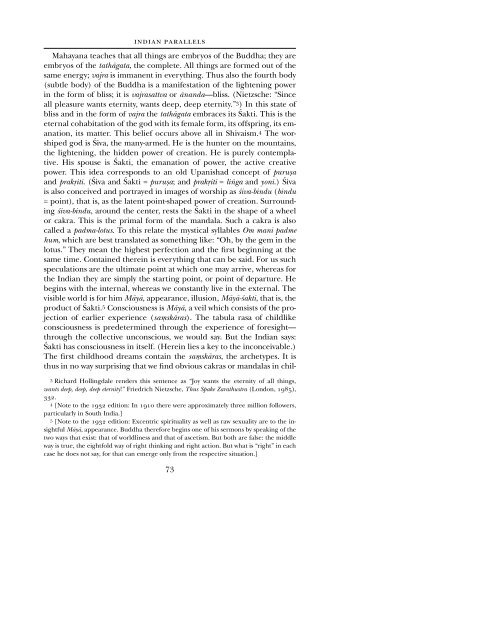CG JUNG - Countryside Anarchist
CG JUNG - Countryside Anarchist
CG JUNG - Countryside Anarchist
Create successful ePaper yourself
Turn your PDF publications into a flip-book with our unique Google optimized e-Paper software.
INDIAN PARALLELS<br />
Mahayana teaches that all things are embryos of the Buddha; they are<br />
embryos of the tathvgata, the complete. All things are formed out of the<br />
same energy; vajra is immanent in everything. Thus also the fourth body<br />
(subtle body) of the Buddha is a manifestation of the lightening power<br />
in the form of bliss; it is vajrasattva or vnanda—bliss. (Nietzsche: “Since<br />
all pleasure wants eternity, wants deep, deep eternity.” 3 ) In this state of<br />
bliss and in the form of vajra the tathvgata embraces its åakti. This is the<br />
eternal cohabitation of the god with its female form, its offspring, its emanation,<br />
its matter. This belief occurs above all in Shivaism. 4 The worshiped<br />
god is åiva, the many-armed. He is the hunter on the mountains,<br />
the lightening, the hidden power of creation. He is purely contemplative.<br />
His spouse is åakti, the emanation of power, the active creative<br />
power. This idea corresponds to an old Upanishad concept of puruüa<br />
and prakùiti. (åiva and åakti = puruüa; andprakùiti = li´ga and yoni.) åiva<br />
is also conceived and portrayed in images of worship as çiva-bindu (bindu<br />
= point), that is, as the latent point-shaped power of creation. Surrounding<br />
çiva-bindu, around the center, rests the åakti in the shape of a wheel<br />
or cakra. This is the primal form of the mandala. Such a cakra is also<br />
called a padma-lotus. To this relate the mystical syllables Om mani padme<br />
hum, which are best translated as something like: “Oh, by the gem in the<br />
lotus.” They mean the highest perfection and the first beginning at the<br />
same time. Contained therein is everything that can be said. For us such<br />
speculations are the ultimate point at which one may arrive, whereas for<br />
the Indian they are simply the starting point, or point of departure. He<br />
begins with the internal, whereas we constantly live in the external. The<br />
visible world is for him Mvyv, appearance, illusion, Mvyv-çakti, that is, the<br />
product of åakti. 5 Consciousness is Mvyv, a veil which consists of the projection<br />
of earlier experience (saôskvras). The tabula rasa of childlike<br />
consciousness is predetermined through the experience of foresight—<br />
through the collective unconscious, we would say. But the Indian says:<br />
åakti has consciousness in itself. (Herein lies a key to the inconceivable.)<br />
The first childhood dreams contain the saôskvras, the archetypes. It is<br />
thus in no way surprising that we find obvious cakras or mandalas in chil-<br />
3 Richard Hollingdale renders this sentence as “Joy wants the eternity of all things,<br />
wants deep, deep, deep eternity!” Friedrich Nietzsche, Thus Spake Zarathustra (London, 1985),<br />
332.<br />
4 [Note to the 1932 edition: In 1910 there were approximately three million followers,<br />
particularly in South India.]<br />
5 [Note to the 1932 edition: Excentric spirituality as well as raw sexuality are to the insightful<br />
Mvyv, appearance. Buddha therefore begins one of his sermons by speaking of the<br />
two ways that exist: that of worldliness and that of ascetism. But both are false: the middle<br />
way is true, the eightfold way of right thinking and right action. But what is “right” in each<br />
case he does not say, for that can emerge only from the respective situation.]<br />
73


